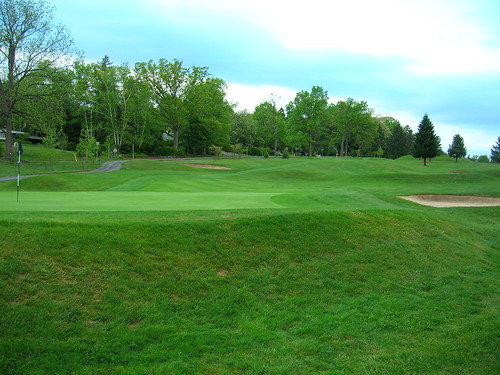Let's take a closer look at the hole.
I envision a hole between 220-240 yards from the back tee with the bunker being 160 yards to carry. I drew a ridge just beyond the bunker with the green below the ridge and the green obscured from the tee. Ideally, the upper portion of the flag is visible. The green should fall away slightly from the tee.
The idea is one of controlling trajectory to best approach the green. The better player is more often able to hit higher shots with longer clubs than players with higher handicaps. This hole affords the opportunity for the higher handicap player to use a shorter club, challenge the bunker and allow the ridge to run the shot on to the green. Meanwhile, the better player is forced to precisely execute a higher trajectory shot or the fall away nature of the green can work against the ball, moving it to a less than desirable position behind the green.
I didn't draw it, but a severe fall off or other form of trouble behind the green would be helpful in furthering this idea.
In practice, one doesn't often encounter such a par 3, but there are a few examples. Kelly Blake Moran has designed two holes such as this: the 3rd at Morgan Hill in Easton, PA and the 5th at Lederach in Harleysville, PA.
Pictured at the left is a view from behind the
 14th green at Penn State's White Course, another example of the idea in practice. This hole is one of the original Willie Park, Jr. holes remaining from 1922. The tee is located at the top of the hill just left of the pine trees. Each "bump" in the hillside are bunkers that appear to sit next to the green from the tee, obscuring the approach from the tee. While the hole plays 190 yards downhill (a mid-iron for better players), attempting to fly the green often proves most difficult as stopping the shot on the green can be tricky given the fall-away design. Missing long makes for a difficult up and down. Simply carrying the bunkers with a low trajectory shot (130yards) provides a much more consistently successful alternative for all calibers of players.
14th green at Penn State's White Course, another example of the idea in practice. This hole is one of the original Willie Park, Jr. holes remaining from 1922. The tee is located at the top of the hill just left of the pine trees. Each "bump" in the hillside are bunkers that appear to sit next to the green from the tee, obscuring the approach from the tee. While the hole plays 190 yards downhill (a mid-iron for better players), attempting to fly the green often proves most difficult as stopping the shot on the green can be tricky given the fall-away design. Missing long makes for a difficult up and down. Simply carrying the bunkers with a low trajectory shot (130yards) provides a much more consistently successful alternative for all calibers of players.Another particularly appealing feature of the idea is that on repeat play, the hole begins to outwit the golfer's mind. Now aware of the possibilities, the golfer may bring the bunkers into play through poor execution.


7 comments:
I like the idea, but 60 yards might be too much run for a short iron.
But not a lower trajectory, punched mid-iron. How far do 20 handicap golfers carry 7-iron?
I would guess somewhere between 130 and 150. But I don't get to play fast courses so maybe I'm not the best judge on run. The first time I played a Ross course I was looking forward to trying a running approach only to see it die a quick death short of the first green.
What course was that? Too often approaches are subject to green irrigation because of overlap of the streams.
Hand watering helps but is costly in terms of labor.
Grove Park Inn in Asheville, NC.
These are the kind of holes that need to be put into practice. Not just for the players this is the kind of hole that would excite the spectator, the very fact that the player will have to use his brains rather than stand on the tee and bomb a long shot, makes for exciting golf.
It is a real thrill to see players successfully use the contours of the green to get that perfect shot. Hopefully such ideas are put into use on golf courses across the globe.
It seems to me that what you might end up with is the high handicappers topping a shot into the bunker or a fat shot and then they are faced with the hardest shot in golf - the long bunker shot. For low handicappers this bunker short of the green would not be in play - sort of like the one in #10 fairway at Augusta.
Post a Comment